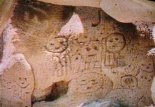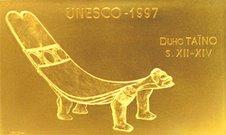by EARL SHORRIS
On the Yucatán peninsula, where many of the Maya of Mexico live, there is an often-told story about people like Mel Gibson, whose bloody movie in the Yucatecan Maya language, Apocalypto, will be released December 8. I first heard the story from Miguel Angel May May, a tall man among the Maya, handsome, now in his 40s, with a touch of gray in his hair. He speaks Yucatecan Maya so eloquently that when young people who have begun to lose their language and culture first hear him, they shed tears for what has been and what can be in the Yucatán.
May May tells the story with the kind of rage and pride that Gibson tried to portray with his Scottish heroes in Braveheart and postapocalyptic picaros in Mad Max: "A Maya, of the middle class, like me," May May said, "went into a Ford dealership here in Mérida. He intended to buy a new pickup truck. He was well dressed, but clearly Maya. The dealer offered him ten pesos to wash a truck." It is a common experience for people of color in a white world. The Yucatán is not entirely a white world, yet the Maya suffer the most severe prejudice of any large ethnic group in Mexico. In the language of prejudice in Mexico, the Maya are said to be people with big heads and no brains, too short, too dark and with a strange, laughable Spanish accent. Gibson accepted the stereotype and embellished it.
To grasp what a racist act Gibson has committed in the making of his new film, it is necessary to understand the world of the Maya as it exists today. Perhaps realizing what has been done to the Maya in the film, Gibson has been seeking allies among Latinos and American Indians. He even went so far as to tell Time magazine, "The fear mongering we depict in this film reminds me a little of President Bush and his guys."
In fact, Gibson stepped into a delicate cultural situation and may have shattered much of what has been built by indigenous people, historians and linguists in recent years. Ethnic prejudice is as harsh in the Yucatán as anywhere in the Americas. I have seen it played out in the Maya villages as well as in the cities and on the beaches. When the Clemente Course, which educates indigenous people as well as the poor in seven countries, taught its first class in the Maya language and humanities in the small village of San Antonio Sihó, the students told me that when they took the bus to Mérida (a journey of more than fifty miles) they were afraid to speak Maya, because people would think them stupid Indians (Mayeros). After two years of study, José Chim Kú, the student leader of the class, said, "Now, when I ride on the bus, I speak only Maya." It took two years for the faculty, including May May, to effect the change, for the Maya have internalized their recent history. And like all people who live in the violent mirror of racial and ethnic hatred, they suffer for their suffering. It is the bitterest irony of colonialism.
In the film Apocalypto, which Gibson claims will make the Maya language "cool again," there are many major roles. The lead is a lithe, handsome young man, a dancer from Oklahoma named Rudy Youngblood. He has indigenous ancestors, but he is not Maya, and like most of the other featured players he is not a professional actor. None of the four other major parts went to Maya either. According to Gibson, they are played by people from the United States, and the other featured players are either from Mexico City or Oaxaca. Yet every word spoken in the film is in Yucatecan Maya, a difficult language to learn or even to mimic, because it is both tonal and accented.
It is not as if Gibson had few Mayeros to choose from. There are more than a million Maya in Mexico, and more than 100,000 of them are monolingual Yucatecan Maya speakers. Yet Gibson chose not one Maya for a featured role. In so doing, he has made a film that reinforces the prejudice against the Maya, who have defended their cultural autonomy as fiercely as any people on earth. Twice they repulsed the Spaniard Francisco de Montejo, before he occupied part of the peninsula in 1527. They continued to fight pitched battles against European cultural and political dominance until the end of the Caste War in the early twentieth century. And even now militant organizations deep in the jungles of the state of Quintana Roo practice ancient rituals and resist Occidental cultural and political hegemony, including the Gregorian calendar. But the people have never been attacked by Hollywood.
Like the owners of the resort hotels that line the beautiful beaches of Cancún and Cozumel, Mel Gibson cast no Maya to work on his project, except in the most minor roles. Maya nationalists think the hotels and tourist packages that use the word "Maya" or "Mayaland" (a translation of Mayab) should pay for what they appropriate for their own use. The Maya patrimony, they say, is neither gold nor silver nor vast stretches of rich farmland; they have only their history, their culture, themselves. Like the hotel owners who bring strangers to the Yucatán to do everything but labor in the laundries and maintain the grounds, Gibson has brought in strangers to take the good parts from the Maya. He said in an interview that he chose people who "looked like you imagined they should," but I have seen photographs of Rudy Youngblood, and he does not look like any Maya I ever saw. One can only ascribe the choice of Youngblood and the other non-Maya to stereotypes that Gibson has adopted.
In casting and producing the film Gibson reinforced a colonialist concept of indigenous people that has long existed in Mexico. Ancient Maya culture was extraordinary, as the rest of the world now recognizes. The Maya invented one of the few original systems of phonetic writing (we are familiar with the Chinese system and the one that culminated in Latin script). They worked with the concept of zero long before it was known in Europe. They were superb astronomers. Their art and architecture are now known and studied throughout the world. It is also true that they were warriors and that they engaged in human sacrifice, although not on the grand scale of the Mexica. Their ability to manage large-scale military and civic works was impressive. Maya literature has a long and grand history, from the ancient words incised in stone through the Pop Wuj (Popol Vuh) and the postinvasion books of Chilam Balam to the eighteenth-century poems ("Kay Nicte"--Flower Song--and others) to contemporary works, including brilliant poetry by Briceida Cuevas Cob in Yucatecan Maya and Humberto Ak'abal in Ki'che and Miguel Angel May May's delightful fables.
Culture doesn't sell tickets. Violence does. Gibson has made what he calls "a chase movie." As we saw his Scot disemboweled and his Jesus battered into bloody meat, we will now see a young Maya running through the jungle to escape having his still beating heart torn from his chest. The social philosophy of Jesus found no place in Gibson's Passion of the Christ, and the glory of Maya culture cannot be featured in a "chase movie." "Blood! More blood!" Gibson shouted during the filming.
According to the Maya calendar, the world will end in 2012, but there have already been four creations in the Maya vision of the cosmos, and there is no reason to think they do not expect another. For the title of his movie Gibson chose a Greek word related to the ideas in the Book of Revelation: apocalypse. Gibson has tried to sell the movie as an allegory, using the fall of Maya civilization to limn the war in Iraq. But it is not about Iraq, and the end of the Maya classic period took place many centuries before the period Gibson chose for his film. The only profound meaning one can take away from the film is that there is an intimate connection between racism and violence. The message of the production is that the Maya are unacceptable people; we do not want to look at them as they are now, and we despise them for what they were then.
Earl Shorris is the editor, with Miguel León-Portilla, of In the Language of Kings: An Anthology of Mesoamerican Literature--Pre-Columbian to the Present (Norton). He has received the National Humanities Medal and the Condecoración de la Orden del Aguila Azteca.
*Article Source:
http://www.thenation.com/doc/20061218/shorris










